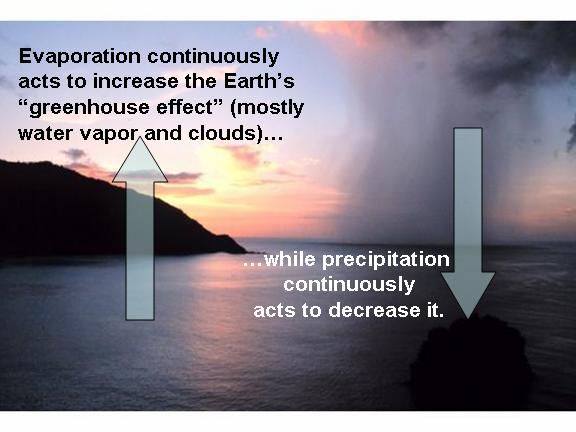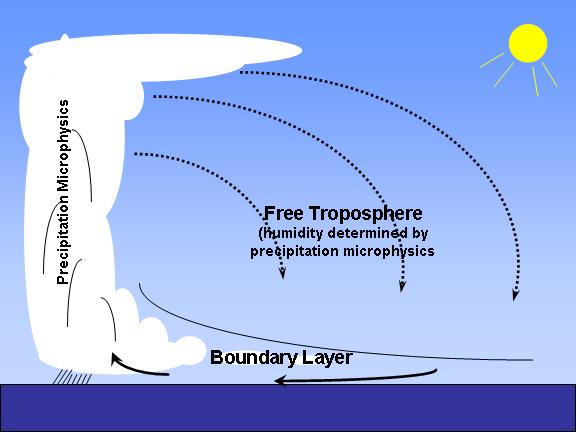Since it has been a while since I have addressed water vapor feedback, and I am now getting more questions about it, I thought this would be a good time to revisit the issue and my opinions on the subject.
Positive water vapor feedback is probably the most “certain” and important of the feedbacks in the climate system in the minds of mainstream climate researchers. Weak warming caused by more carbon dioxide will lead to more water vapor in the atmosphere, which will then amplify the weak warming through water vapor’s role as the atmosphere’s primary greenhouse gas.
Positive water vapor feedback makes sense intuitively. Warmer air masses, on average, contain more water vapor. Warmer air is associated with greater surface evaporation rates, which is the ultimate source of almost all atmospheric water vapor.
And since water vapor is the atmosphere’s main greenhouse gas, most scientists have reasonably inferred that climate warming will be enhanced by increasing water vapor amounts. After all, water vapor feedback is positive in all of the IPCC climate models, too.
But when one looks at the details objectively, it is not so obvious that water vapor feedback in the context of long-term climate change is positive. Remember, it’s not the difference between warmer tropical air masses and cooler high-latitude air masses that will determine water vapor feedback…its how those air masses will each change over time in response to more carbon dioxide. Anything that alters precipitation processes during that process can cause either positive or negative water vapor feedback.
Here are some of those details.

1) Evaporation versus Precipitation
The average amount of water vapor in the atmosphere represents a balance between two competing processes: (1) surface evaporation (the source), and (2) precipitation (the sink). While we know that evaporation increases with temperature, we don’t know very much about how the efficiency of precipitation systems changes with temperature.
The latter process is much more complex than surface evaporation (see Renno et al., 1994), and it is not at all clear that climate models behave realistically in this regard. In fact, the models just “punt” on this issue because our understanding of precipitation systems is just not good enough to put something explicit into the models.
Even cloud resolving models, which can grow individual clouds, have gross approximations and assumptions regarding the precipitation formation process.

2) Negative Water vapor Feedback Can Occur Even with a Water Vapor Increase
Most atmospheric water vapor resides in the lowest levels, in the ‘turbulent boundary layer’, while the water vapor content of the free troposphere is more closely tied to precipitation processes. But because the outgoing longwave radiation is so much more sensitive to small changes in upper-layer humidity especially at low humidities (e.g. see Spencer & Braswell, 1997), it is possible to have a net increase in total integrated water vapor, but negative water vapor feedback from a small decrease in free-tropospheric humidity. See #4 (below) for observational support for this possibility.
3) Cause Versus Effect
Just because we find that unusually warm years have more water vapor in both the boundary layer and free troposphere does not mean that the warming caused the moistening.
There are a variety of processes (e.g. tropospheric wind shear causing changes in precipitation efficiency) which can in turn alter the balance between evaporation and precipitation, which will then cause warming or cooling as a RESULT OF the humidity change – rather than the other way around.
This cause-versus-effect issue has been almost totally ignored in feedback studies, and is analogous to the situation when estimating cloud feedbacks, the subject of our most recent paper.
Similar to our cloud feedback paper, evidence of causation in the opposite direction is the de-correlation between temperature and humidity in the real world versus in climate models (e.g. Sun et al., 2001).
4) Evidence from Radiosondes
There is some evidence that free tropospheric vapor has decreased in recent decades (e.g. the Paltridge et al., 2009 analysis of the NCEP Reanalysis dataset) despite this being a period of surface warming and humidifying in the boundary layer. Miskolczi (2010) used the radiosonde data which provide the main input to the NCEP reanalysis to show that the resulting cooling effect of a decrease in vapor has approximately counterbalanced the warming influence of increasing CO2 over the same period of time, leading to a fairly constant infrared opacity (greenhouse effect).
Of course, water vapor measurements from radiosondes are notoriously unreliable, but one would think that if there was a spurious drying from a humidity sensor problem that it would show up at all altitudes, not just in the free troposphere. The fact that it switches sign right where the turbulent boundary layer pushes up against the free troposphere (around 850 mb, or 5,000 ft.) seems like too much of a coincidence.
5) The Missing “Hot Spot”
Most people don’t realize that the missing tropospheric “hot spot” in satellite temperature trends is potentially related to water vapor feedback. One of the most robust feedback relationships across the IPCC climate models is that those models with the strongest positive water vapor feedback have the strongest negative lapse rate feedback (which is what the “hot spot” would represent). So, the lack of this negative lapse rate feedback signature in the satellite temperature trends could be an indirect indication of little (or even negative) water vapor feedback in nature.
Conclusion
While it seems rather obvious intuitively that a warmer world will have more atmospheric water vapor, and thus positive water vapor feedback, I’ve just listed the first 5 reasons that come to my mind why this might not be the case.
I am not saying that’s what I necessarily believe. I will admit to having waffled on this issue over the years, but that’s because there is evidence on both sides of the debate.
At a minimum, I believe the water vapor feedback issue is more complicated than most mainstream researchers think it is.
 |

 Home/Blog
Home/Blog



